MHHV Seminar 18 October 2019 ANZAC House Collins St Melbourne.

The conference of around 80 attendees was opened by convenor Colonel Marcus Fielding.
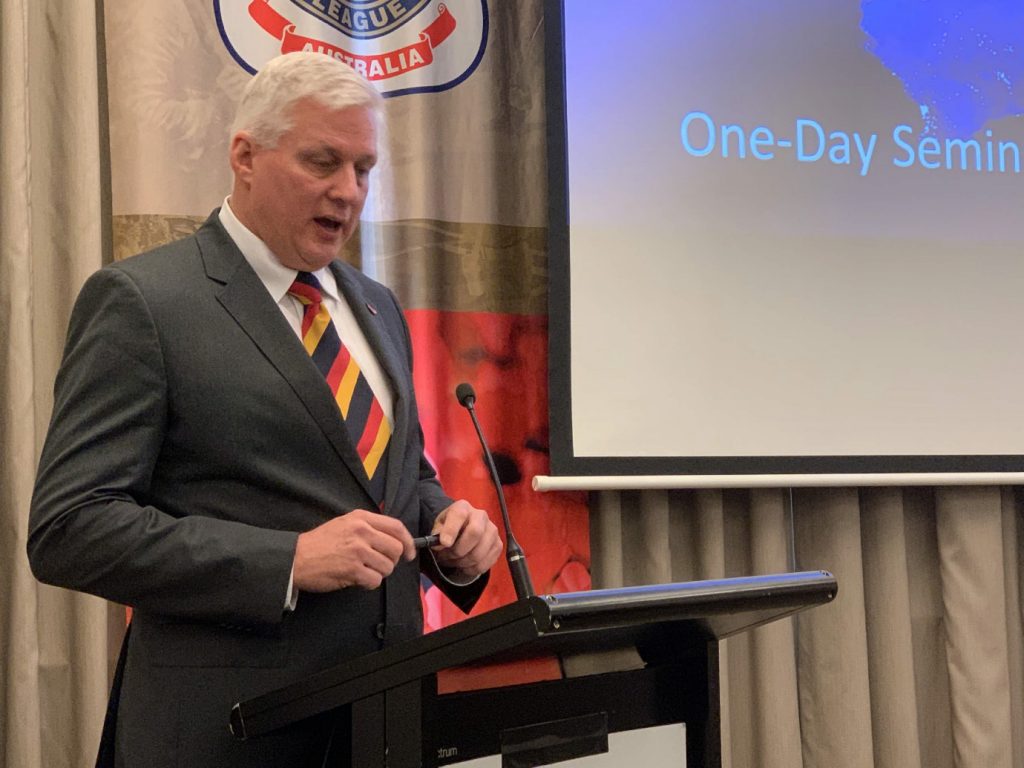
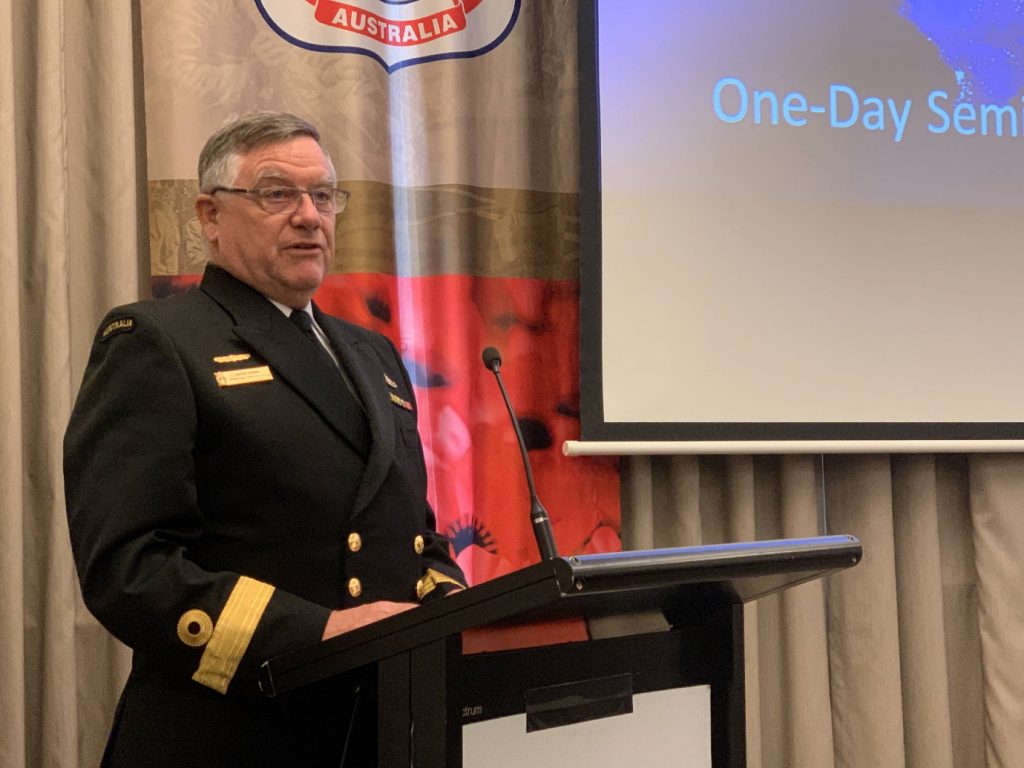
In his welcome address, Commodore Greg Yorke stated that we live in interesting times as world order is changing rapidly. In that context, this conference sought to answer how Australia might deal with the challenges, how it would defend itself and what it might choose to protect.
Pre-Federation to Post-First World War by Dr Tom Rogers, historian in the Military History Section at the Australian War Memorial.

Dr Rogers explained that early colonial settlement saw increasing tensions in the nation between feelings of loyalty to the British Empire on the one hand and identifying with Australia. People often felt like British Australians. These dichotomous feelings were brought into sharp relief by the Boer War.
After a century of tension with the Dutch in South Africa over gold and diamonds, the British decided to take charge of the country in what they thought would be an easy conquest. It was not to be so. Well into an increasingly bitter war, 10 – 17 December 1899 became known as ‘Black Week’ after the British were beaten in three hard fought battles. With the title of world power in jeopardy, a wave of British patriotism surged around the Empire. Men and money came forward in abundance. When the cities of Cape Town and Johannesburg were captured in June 1900 Britain thought it was all over – it wasn’t.
The Boers resorted to guerrilla warfare. In response, the British became punitive. They burnt farms and filled concentration camps with Boer families. Debate raged about this inhumanity and whether Australia should stick with Britain no matter what.
The naysayers were in the minority. Australia stayed with Britain. When the call went out for 2,200 volunteers it was ten time over subscribed. This was in part because Australians felt they had something to prove. The national identity was imbued with the belief that Australian bushman had natural talents to beat the Boers but doubts about how they would measure up against the British. The Australian’s had something to prove. In addition, it was also believed that it was in Australia’s interests to support Britain in the hope they would reciprocate if Australia was threatened.
This war provided no end of lessons for the Australians which helped calm their anxieties about their own inferiority. The British war machine did not run efficiently or effectively. British soldiers may have looked good on the parade ground, but the Australians compared well in battle. Further, British logistics was poor and supplies often couldn’t keep up with the mounted soldiers. Men were often starving. Worse, the death rate of horses was 67% because the huge tonnages of fodder required couldn’t get through. Australian soldiers felt the death of horses keenly. So, while the mounted forces were necessary for the war, for want of horses, the force was frequently better described as the dismounted rifles.
A crisis in national ‘sovereignty’ occurred when two volunteer soldiers in the Australian force were sentenced to death for minor infractions of discipline. While the executions weren’t carried out, this motivated the Australian Government to pass the Defence Act of 1903. This act stated that Australian volunteer soldiers could not be executed without the explicit agreement of the Australian Government. Australia stayed firm on this in World War I.
There is a view that nations, such as America, are forged in war. Contrary to this, Australian Federation was peaceful. While many issues were subject to heated argument during the formation of the nation, it was more-or-less agreed from the beginning that the defence of the continent should be national and centralised. Peacetime national service was introduced between 1910 and 1913 supported by the progressive idea that universal suffrage implied universal commitment.
Australia joined Britain in WWI not only because of loyalty to Empire or in the hope of reciprocal defence but also because Germany was a national threat to Australia. Australia’s north was fringed by German possessions and had Germany won the war, this would have greatly affected Australia’s security. At the Versailles Peace Conference, Prime Minister Billy Hughes successfully argued hard for Australia to take over some of the Germany’s possessions in the Pacific to the immediate north. He won this argument and in so doing achieved a geographic defence buffer between Australia and Japan’s possessions further north which were also ‘won’ from the Germans.
The other lesson to come out of the war was that by 1918 it was realised that while Australians may be natural fighters, professionalism and discipline is required of a national force. This required a standing force commanded by a cadre of professional officers.
The Inter-War Period to the Cold War by Emeritus Prof David Horner.
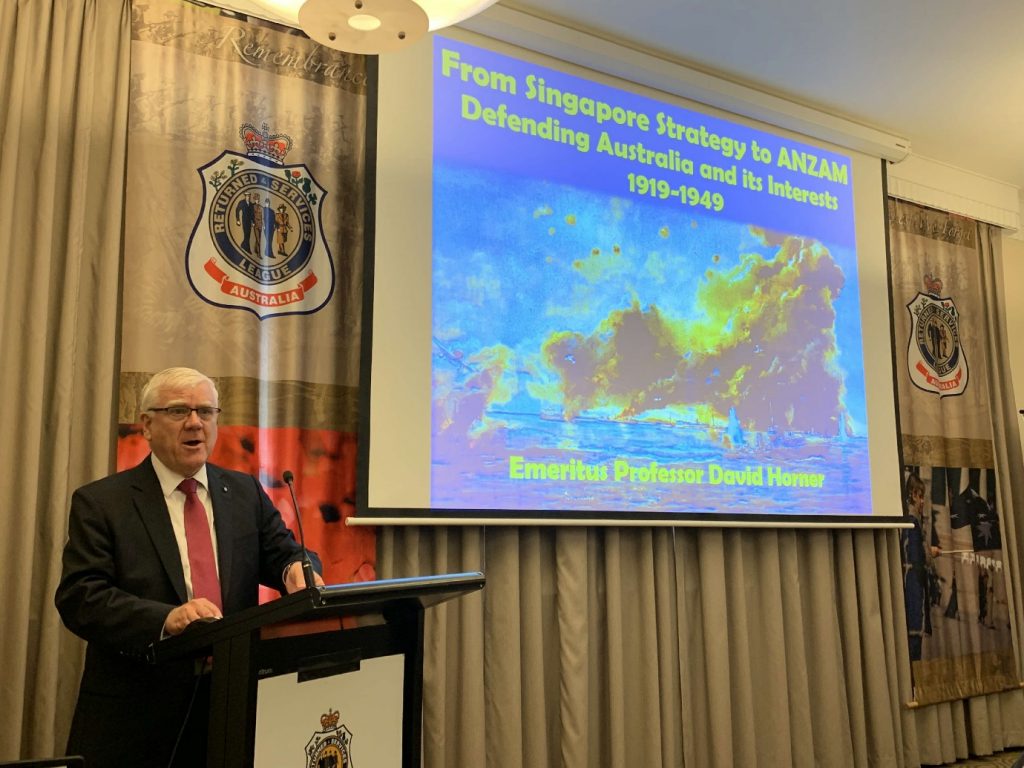
Dr Horner explained that there were four main phases of defence policy between 1919 and 1945.
1919 marked the end of the First World War with the challenges arising because both Britain and Australia were weakened by the war. Japan was recognised as an emerging threat in the region.
Despite Britain’s protestations, Australia decided to invest in its own protection by building up a navy along with a militia force of two cavalry and five infantry divisions. That commitment notwithstanding, Australia’s defence was continually watered down because of economic pressures in the recessionary inter-war period.
In 1923 Australia adopted the Singapore Strategy. In this, Britain undertook to develop Singapore as a huge defensive naval base to act as a bulwark against Japanese aggression. The Australian Navy supported this strategy, but the army did not as the strategy had an obvious weakness; it could only work if the British Navy wasn’t required elsewhere.
The government embraced the strategy as an act of faith, most likely because it saved money. The Navy continued to grow but the army was depleted.
In the grip of the Great Depression, Australia was still without a clear strategy even though it became obvious that there were expansionist moves by Japan and Germany. The Navy continued to expand, and the army was brought up to 70,000 militia and 4,000 regular troops. As war in Europe began, Menzies instituted the Empire air training scheme in which large numbers of men trained as air crew and were sent to the UK. This lasted for the whole war despite heavy losses and strenuous objections from the Australian military.
The decision was taken to deploy the 2nd AIF overseas after Prime Minister Menzies was promised Britain would defend Australia. With that promise it was argued that their presence would not be required at home.
Following the fall of France, the Japanese occupied Vietnam. With the British Navy heavily committed in the Atlantic and Mediterranean, the Singapore Strategy started to look dubious.
Australia’s strategic defence now became local. Australian could do little but deploy small units around near neighbours including the 8th Division to Singapore and Malaya.
With the outbreak of the Pacific War on 7 December 1941, the US and Britain adopted a beat Hitler first policy. Australian soldiers distributed in the Asia-Pacific region were overwhelmed by the Japanese and the survivors marched into horrific captivity. The Singapore Strategy ended as the Australian Army had feared.
Australia brought the army and navy back but the airmen of the Empire scheme remained in Europe. Prime Minister Curtain ceded sovereignty to the US for the protection of a powerful ally in return for giving the US bases and supplying an early land force. By mid-1943 when Australia was out of imminent danger of invasion, the government realised there was insufficient manpower for both productive and military needs but were obliged to keep six divisions in the war in order to have a voice in the defence policy of the region. This strategy has echoed through defence strategy for the following seventy years.
In 1944, Australia and New Zealand banded together to agree a pact that the islands to the north of them in the Pacific would to come under their control. This was largely agreed.
In 1947 the Foreign Minister Herbert Evatt decided we needed allies other than the US and chose a close association with the United Nations first and Britain second on the understanding that Australia had the inherent right to self-defence. But there was a problem with insufficient money so the RAN and RAAF were dependent largely on British WWII equipment to maintain interoperability with the British.
The strategy was to keep a small capable force of permanent and reservist members in case the allies could not be relied on.
The Cold War Era by Prof Peter Edwards.
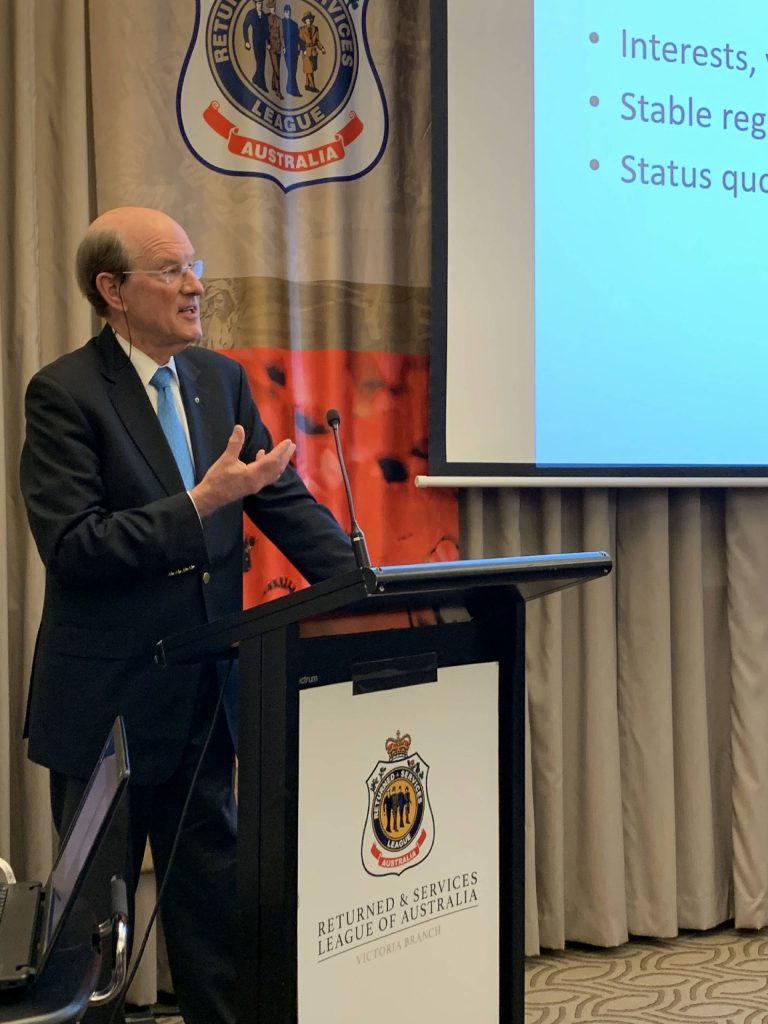
Prof Edwards started by noting that Australia almost always protected its interests by being part of a military coalition under a stronger power – for example Britain, the USA, or the UN. In addition, it generally defended the status quo and in that sense was not revisionist.
In terms of strategy, it had four main emphases that changed after each significant war.
In the 1901 to 1914 period, particularly under Alfred Deakin, Australia sought to have its ‘cake and eat it too.’ It framed its alliance being as both an independent nation while dependent on Britain’s protection.
Between the world wars Australia doubled down on the Imperial side and became much more dependent on Britain for defence as well as trade and capital. The Singapore Strategy was key to Britain’s strategy for the defence of its far-flung dominions in the Asia-Pacific area. The Australian government accepted the Singapore Strategy as an article of faith despite being given strong warnings against it by its own military commanders.
The Cold War period 1945 to 1965 was at a time of great global change. There was the global threat from communism. It was a particularly confusing time for Australian defence strategy because Britain’s had shown they were unable project power into the Asia-Pacific region and thus were unable to be involved in Australia’s defence. In 1954 Britain made it official said it wouldn’t go into Indochina, so Australia’s main alliance was inevitably with America.
In addition, the old empires were unable to maintain their colonies. Rapid decolonisation in SE Asia, Africa and elsewhere made it difficult to tell if the insurgents were ‘genuine’ nationalists or communists which confused the decisions to become militarily involved.
While Australia’s strategy was not set out in white papers, it was revealed by the decisions taken or not taken. Australia implicit strategy was to be involved in forward defence only in SE Asia. It strongly resisted almost all British efforts to become engaged in their European, African and Indian adventures. The Suez Conflict was a slight aberration, the decision to be involved was made while Menzies was absent. But Australia sent only a token force.
Australia would only enter a conflict if invited by a legitimate authority. Australia’s involvement in Korea was a good example of this. Australia became involved at the request of the United Nations. The force was multi-national and multi-racial so that it was not just white people telling Asians what to do. Being involved relied on US power but not necessarily their strategic judgement. Menzies, who was PM for most of that time, trusted British judgement for foreign policy over that of the Americans and understandably it was very tricky keeping both nations on side.
When entering an alliance since World War II, Australia opted for a graduated response. It began by supplying the smallest force it could get away with; a force that would provide legitimacy and was useful to the allies but wouldn’t cause too much trouble at home. Typical the graduated response would begin by providing essential services. This may be by providing transport planes then escalate under pressure to naval blockades. It would be useful to the alliance by supplying resources but would short fall short of providing a combat force. The next step may be to send army engineers, trainers and then as a last resort to send fighting men. Australia always found it hard to send more than a battalion.
During this period each of the services had their own department and supply system. There was little appetite for joint decision making. All major defence decisions came down to the PM.
In the period 1975 to 1986, all things associated with the Vietnam War came into question. This included the policy of forward defence and the US Alliance. Defence was still considered important, but it was hard to figure out who Australia was defending against.
From 1987 into the 1990s the approach emphasised the defence of the Australian continent and the all-important air-sea gap. With no real offshore threat, the RAN and RAAF became more important and the Army less so. While China was emerging as a potent military nation and Muslim terrorism foreseen the real problem for defence strategy was that there was no credible threat.
The defence system in Australia was reformed by placing all services under a single department. Policy making improved, intelligence organisations were integrated and supported.
While the alliance with the US was still important, they could not be relied to lead in conflicts that the perceived as not in their direct national interest. They would not be drawn into East Timor in 1999. For the only time, Australia led the action. America supported by providing much needed equipment – in fact the Australian shopping list was agreed by the Americans within 24 hours.
The Post-Cold War Era by Prof Peter Leahy.
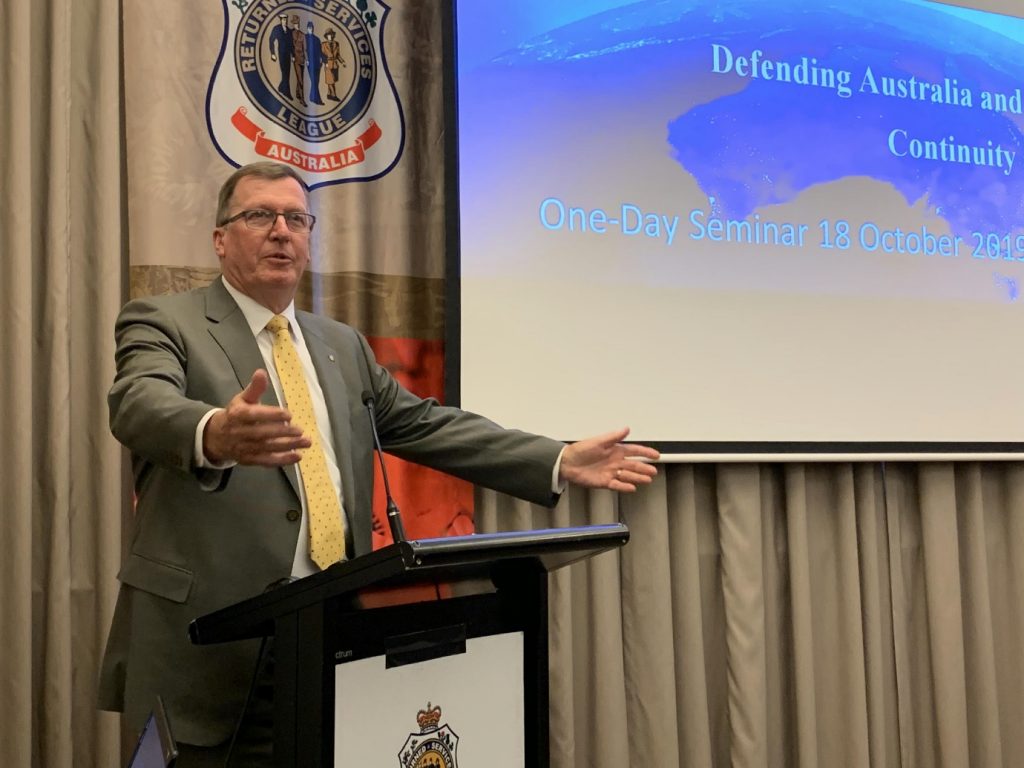
Professor Leahy began by noting that the Cold War was a time of intense competition between communist USSR on the one hand and capitalistic America on the other. The USSR wilted under the pressure. Despite this, the Cold War was not resolved as western liberalism has not been universally successful.
While there haven’t been any global scale wars post-Cold War, there have been many serious conflicts. Most of these have been within populations and more needing anthropologists than soldiers. The nature of war has changed. In these conflicts women and children have been extensively involved as belligerents. There has been peacekeeping in all forms exemplified by a loose articulation of national interests along with a paucity of resources.
Citing the work of author Philip Bobbitt, he noted that the wars since 1900 were not discrete events but rather part of a continuous struggle to decide what the form of government should be adopted following the imperial era. The dominant choices of government in the last century were fascist, communist or liberal democracies. Two new forms have been added this century; namely the market state or theocratic state (Islamic). The conflicts go on as it has still not been resolved whether governments should take one of the popular forms or be something else.
Australia is a strategy taker not a strategy maker. It would be nice to say Australia had compelling reasons to engage in any of the wars of recent times that is not so. Our primary strategy has been forward defence hopefully ‘guaranteed’ by supporting our powerful friends. Aside from this there is rarely any strategic analysis of why we fight overseas and there is no analysis of how our values and interests fit the situation. As an example of our ‘dependent’ defence policies, when 9/11 occurred, the then Prime Minister Howard anticipated a rapid retaliatory action by America. Howard rang the speaker and said “Peter, get the army ready, we’re going to war.” Vengeance is a bad reason for war.
Having got into Afghanistan and Iraq, it is hard to see why we stayed in. On the way in, no one asked what victory looked like so there was no natural exit point. Fighting for oil is often posited as a reason to fight in the Middle East. But if protecting Australia’s or America’ oil supplies was one of the reasons for being there Prof Leahy could not recollect it being mentioned.
A national defence strategy may have changed our involvement in wars. There have been many calls for a national security strategy but so far it hasn’t happened because the culture and decision-making takes decades to change.
Panel Discussion with the previous four speakers and the Hon Prof Brendan Sargeant facilitated by Marcus Fielding.
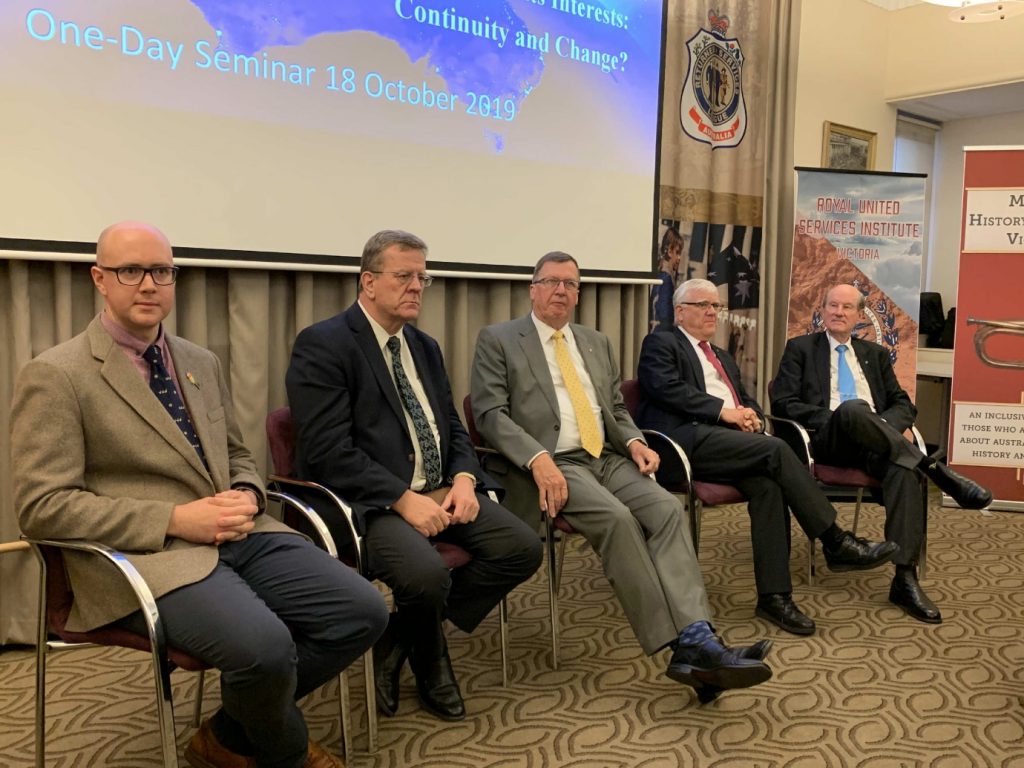
Protecting Australia and its interests is a primary objective of defence policy. How that is done should be reflected in Australia’s defence policy which in turn should be guided both by our interests and values.
As an example of values and interests influencing national defence, the previous PM Malcolm Turnbull noted ‘the countries in our region want the freedom to be themselves.’ To that end, Indonesia and India have constitutions that say what they stand for and show where their ‘red lines’ are. Australia doesn’t.
Alternatively, Prime Minister Hawke gave a short summary of our national values when he answered the question about why Australia was involved in Kuwait by saying: Australia supports the US Alliance and the UN and we need oil for a strong economy.
Australia, while free to be itself, finds values very hard to articulate particularly as there are ‘so many victims we are running out of offenders.’ Yet despite this causing fragmentation of emphasis, an evolving list values related national interests can be articulated.
Our values could include something like ‘we want to live in a world fee of coercion’. Alternatively, ‘helping little girls go to school’ was the response of a digger when challenged about being in Afghanistan. Both are simple explanations for Australia’s values-based reasons for engagement.
Australia is not comfortable with the exercise of power so inevitably we trade some sovereignty for security. In most engagements, self-reliance of our force is a fantasy. There are however times when we have to step up as we did in East Timor. In that engagement, US refused to lead so Australia did. This sort of situation may arise more often as the US withdraws from this part of the world.
However, Australia can’t send in the gun boats for every cause or threat. There is a need for us to project both hard power and soft power. Unfortunately, Australia’s diplomatic and foreign affairs capability and presence is winding down and while our military is getting better at quasi-diplomatic roles it is inadequate for the task.
Currently the government is managing defence piecemeal department by department. Cabinet ministers are getting competing advice which obviously make the whole system inefficient. There is need of an integrated approach to national security.
Further overall defence management is being hampered because politicians and staffers come from narrow unrelated backgrounds and live a sheltered existence in Canberra. This situation is exacerbated by the long years of peace and prosperity enjoyed by Australia. It has deprived staffers and ministers from experiencing any existential crises. Educating politicians and staffers in strategic thinking early in their careers may help solve some of this problem.
The next national crisis could be a ‘come as you are war’. Problematically, Australia takes too long to do things and is too slow to change. There are big risks in not being adaptable particularly as the strategic balance of the world is changing rapidly and we, while growing, are getting relatively smaller. We probably don’t have to worry in the short-term, but we do in the long term. In the meantime, while the Chinese or Indonesians aren’t coming there are huge transnational threats related to cyber and money movement.
In summary – we are at a big moment in our history. We are moving from being an extension of an alliance to making decisions for ourselves and exercising power without the support of a powerful other. That will be a challenge to our identity. We will have to decide what we want to be in the world. We will have to think for ourselves and do it rapidly. That is a big step for the nation to make but we have done it before in the time leading up to Federation and we can do it again.
SPEAKERS AND PANEL DISCUSSION PARTICIPANTS
Tom Rogers – Historian in the Military History Section at the Australian War Memorial, where he researches colonial Australian history, the South African (Boer) War, and the First World War. His research interests include colonial Australian and British Empire history and military and political history.
David Horner – Emeritus Professor of Australian Defence History at Strategic and Defence Studies Centre, Australian National University. His research interests include Australian defence history, particularly strategy, command, intelligence and operations and current defence issues. He is the Official Historian for the Australian Peacekeeping and Post-Cold War Operations.
Peter Edwards – Official Historian of Australia’s Involvement in Southeast Asian Conflicts 1948–1975. He was the author of the volumes dealing with politics, strategy and diplomacy, Crises and Commitments (1992) and A Nation at War (1997), and general editor of the nine-volume Official History.
Peter Leahy – Director of the National Security Institute, University of Canberra and retired senior officer of the Australian Army. His military career culminated with his appointment as Chief of the Army from 2002 until 2008. He is also the patron of the Military Historical Society of Australia.
Brendan Sargeant – Honorary Professor at Strategic and Defence Studies Centre, Australian National University. He has had wide experience with the Australian Department of Defence and has held senior appointments including Head of Strategic Policy Division, Deputy Secretary Strategy and Associate Secretary.
Contact Brent D Taylor about this article.






